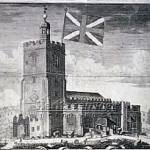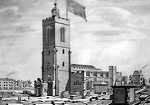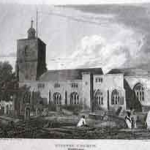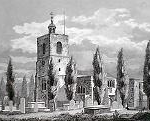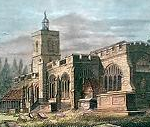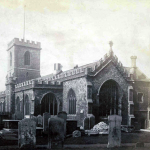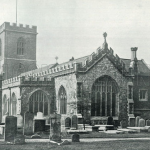Stepney’s bells
A History of Stepney’s bells goes back at least 625 years and as might be expected, some of the detail has been lost (if it had ever been fully recorded). Some of what I have found at the Guildhall Library, the London Metropolitan Archives, the internet and the tower itself is recorded here, with some conjecture linking together bits of information.
In 1419, money had been left in the will of parishioner Vincent Sylkaid to build a ‘campanile’, so it can be inferred that bells, if not already present in some installation, were aspired to. There would probably at least have been a single ‘turret bell’, possibly mounted at a gable end and swung via a rope reaching down to the ground floor. A turret bell existed at Stepney – as a separate installation – until at least 1789 when it was repaired and rehung. It possibly remained until the major refurbishments of the church in early Georgian or late Victorian times.
Building a tower for bells indicates the importance laid on the distance their sound could travel: the higher the bells, the further away their call to prayer could be heard. There is reference to the construction of the bell tower in 1425, 1426 and 1433, but how many bells there might have been in this tower I did not find. Money was also bequeathed to repair bells in 1474, so there may have been more than one, but a subsequent purchase indicates there was at least one.
Incidentally, sending the sound of the bells out as far and wide as possible would have been quite important for Stepney, because until the early 14th century the church served the whole of Middlesex east of the City of London (reputedly, the largest parish in Western Europe). The first east end churches to augment Stepney’s were built at Bow (1311) and Whitechapel (1329, originally a chapel of ease to St. Dunstan).
In 952 AD Dunstan, the Bishop of London (later Archbishop of Canterbury), replaced the wooden chapel on the site with the first church built of stone. The existing church is the third on the site and was built of Kentish ragstone mainly in the 15th century, so possibly Sylkaid’s gift was a direct response to plans afoot in his lifetime to build a new church.
At Dunstan’s time, the church’s only dedication was ‘All Saints’. We are told the dedication to Dunstan was added when Dunstan was canonised (1029). Interesting to note, is that Dunstan is reputed to have a connection with bells. Dickon Love’s website tells us that Dunstan “…was a very talented man, who is said to have been a fine scribe and illuminator, a skilled musician with an excellent voice and a very dextrous metalworker. Bell founding was another of his talents and he is said to have cast bells for Abingdon Abbey and Canterbury Cathedral.”
The Tenor Bell
It is customary for sets of bells to be ‘represented’ by the weight and note details of the tenor bell. Our tenor is no exception, and it also bears an inscription detailing its own history and by extension the history of the set over which it has ‘presided’, beginning in the late Middle Ages, when the original tenor was donated to Holy Trinity Priory. This provenance and a summary of every subsequent major event in its existence (i.e., recasting) is as follows:
THE LATE TENOR WT. 49 CWT WAS GIVEN TO THE PRIORY OF THE HOLY TRINITY DUKES PLACE ALDGATE BY NICHOLAS CHADWORTH AND RENEWED BY THOMAS MARSOW 1386 WAS SOLD WITH THREE OTHERS BY SR THOMAS AUDLEY TO THE PARISH OF ST DUNSTANS STEPNEY ABOUT THE YEAR 1540 RECAST 1602 1764 & 1799 THE LATE PEAL OF 8 BELLS WERE RECAST INTO TEN BY THOMAS MEARS & SON, 1806, IN THE PRESENCE OF GEO. HARPER D.D. RECTOR REVD THOS THIRLWALL LECTURER, MR MATTW EASUM ROBT TURNER WM WADE WM THOMSON GEO EVERITT CHURCH WARDENS JNO CURTIS ESQR JNO EDWARDS ESQR JEREMH SNOW ESQR JNO PAULIN WM SIMONS MATTW WARTON SURVEYOR JNO SALTER VESTRY CLERK
Precisely who Nicholas Chadworth was I haven’t been able to ascertain, but there was a wealthy family of Chadworths in Tower Hamlets in the Middle Ages. It’s not clear whether Thomas Marsow was a bell founder or the man who paid for the bell’s 1386 renewal.
Holy Trinity, founded in the early 12th century by Maud, first queen of Henry I and formerly a very powerful and wealthy priory (St Katharine Cree was the parish church of the Holy Trinity Priory), was dissolved – in 1532 – four years before Henry VIII’s sweeping ‘official’ dissolution. Owing to mismanagement, the priory was already in decline and in overwhelming debt to the crown by this time. It volunteered to surrender possession to the crown (or by some accounts, abandoned the property two years before the crown moved in to take possession). The site and all of the priory’s property was, like much church property subject to dissolution, given to one of the King’s supporters (probably also a creditor) – in this case, Lord Audley – in 1534. In 1540 Audley sold the tenor bell and three others to the parish of St Dunstan Stepney.
The bells bought from Audley therefore would have joined at least one bell and possibly replaced other bells already in Stepney’s tower – how many is not clear, however a document of 1570 notes that repair was needed to the ‘Great Bell of 5’ – five bells seems a common number for a respectable set of bells in the 16th century – four of which it seems were those acquired from the dissolved Holy Trinity Priory.
Bells are costly to make and to maintain – amongst the most expensive chattels of an average church – and valuable enough that some effort went in to paying for their maintenance. Respecting the fact that by 1598 it had been declared the ‘great bell’ was unusable, it was agreed by the churchwardens in April 1599 that
Laurence Wright of Hownsditch in the parish of St. Botolph’s without Aldgate London Bellfounder should have the casting of the great bell called the 5th bell and for the casting thereof to have £40 viz £10 at the taking of her downe and carrying her away & at the hanging of her up after new casting £10 more and the residue of the said some at the end of vj months after the hanging and to be bound with an able surety in certain Articles inden for the performing thereof as shall be devised.
Note: According to the calculator at www.measuringworth.com, the current value of £40 0s 0d in 1599 is nearly £6,000 (using the retail price index – or RPI) or nearly £80,000 (using average earnings – AE). As the work would have involved both materials and labour, the actual sum must have been somewhere between the two. As this is the cost for only one of the bells, it is clear bells are just as expensive then as they are now.
However, recasting didn’t take place until 1602 and it seems likely that although church officials had decided the work should be undertaken by Laurence Wright of Houndsditch in 1599, their inability to pay may have postponed the work. The problem was that the parishioners refused to pay.
Tenor recast 1602 amid controversy
As the inscription notes, over the centuries the largest bell was recast several times. As parish equipment, the cost of this work was borne by the community and raised by various means from the community at various times.
At this period, bells signaled both sacred and secular messages to the community: they indicated to the outside world various points in holy services taking place within, were rung for funerals and for various state occasions and were also used to mark key hours such as the start of the working day and curfews. So, in 1598 when the tenor had to be recast, the churchwardens were sent out to collect an extra sum of money from every parishioner to pay for the work. In that year it was agreed
That every parishioner within the [Parish of Stepney] shall gyve towards the same one yere’s pew rent over and besides their quarters rent now due: And every parishioner that hath no pew appointed for him or her shall pay viijd [8 pence] according to th’auncient custome of this parish over and besides his or her quarterly duties now or hereafter due and payable.
By 1601, ‘to the great vexation lett and interruption of the Churchwardens’ many parishioners had not paid up. In the meantime, the fourth bell was also in need of repair. When churchwardens called to collect taxes, parishioners ‘(of whome some are Auncient & of Long continuance)’ either refused to pay or were ‘abroad’ when the churchwardens called. It was decided that those who refused to pay were to be dealt with as the Churchwardens saw fit (one wonders what drastic action was envisaged or taken!).
The parishioners’ reluctance to pay for expensive repairs to bells may have been because their bells had received some additional use (some might say misuse) that was not strictly in the service of the parish.
Full circle ringing had not yet fully developed. Stepney’s bells may have been mounted with quarter-wheels or half wheels, but full wheels were just around the corner. I was unable to find evidence of when St. Dunstan’s bells underwent the adaptations that progressed from partial wheels to full wheels, but experiments and modifications may have been taking place around this time, coinciding with an interest in ringing as an exercise separate from spiritual office or civic notification, pursued for its own sake particularly amongst groups of young men who were developing the art of ringing changes.
An entry in St Dunstan’s parish records deposited at the London Metropolitan Archives records:
The xviijth day of July 1600 It was then and there ordered by vs parishioners vestry men… That the sexton shall not at anie tyme hereafter ring any peales with the Bells of the parish church of Stepney or suffer any to ring without the consent of the Churchwardens of this Parish or any twoo of them, first had & obtained upon payne of such displeasure doing the contrary as to the vestry men in that behalf shall think good Witness under or hands, the day and yere abovewritten aforesaid.”
It seems the sexton (called Francis Whitacre) may have been involved with (or happy to augment his sexton’s income via payment from) the young men who roamed on early ‘outings’, ringing bells for recreation, adapting bell mountings, trying their new compositions and testing their abilities to perform the changes, challenged by the qualities of different sets of bells. Thirty-seven years later a group of such young men would formally establish the Ancient Society of College Youths.
Francis Whitacre obviously put an interest in extra-curricular ringing (or the personal profit to be gained by giving ringers access to Stepney’s bells) above his duties as a sexton. The next year he was ‘utterly dismissed’ for his irresponsible behaviour, for insulting a churchwarden (he bid him ‘shake his eares emonng doggs’!) and for encouraging the Parish Clerk to join him in taking as much profit as their positions within the church allowed. It was further alleged of the sexton
Item: for taking in of a bell and delivering the same bell out of the steeple without the consent of the churchwardens and parishioners, which was chargeable to the parish. … Item: for the great chardge, that the said sexton hath put the parishioners unto by his negligence for not looking dutifully unto the bells.
This unauthorised work involving the bells – possibly augmenting the 5 to 6, possibly adapting their mountings – resulting in damage and the ‘great chardge’ was the source of churchwardens’ difficulty and parishioners’ reluctance to pay.
The church and parish were so exercised by the sexton’s ‘want of skill’ that after his dismissal it was decided to appoint a man particularly to look after the bells. The first steeplekeeper (though that title was not used at this point), Edward Parberry – a cobbler by trade – was appointed 1602.
For his wages in that behalf: he the said Edward Parberry shall have paid him by the churchwardens of this parish fforty shillings yerely and also shall have for his dwelling or to work in, the shop adjoyning upon the church howse in the church yard of this parish without paying any rent for same So long as he shall well behave himself unto the vicar, Churchwardens and parishioners of this parish: And shall be diligent in the executing of his said place: The first quarterly payment for his wages to begin at Xmas next.
I have found no record of how well (or poorly) Edward Parberry executed his duties, nor have I found any record of his successor in the post. Perhaps after a decade or so of smooth operations, the care of the bells did not so exercise the church administration and the post of steeplekeeper ceased to be a church appointment.
Perhaps visits by change ringers were becoming more regular, and perhaps although initially unwelcome, grew to be more accepted. In parish records of 1637 there is evidence that the church could realize some income from the bells by levying a charge for their use ‘when any ringing shall be extraordinary’, which implies that ringing that was not for a service, a funeral, a state occasion or a curfew – but possibly for the sake of ringing – was becoming something to anticipate regularly. This charge is recorded as being two shillings and sixpence ‘for every peal they shall obtaine leave to ring’. In 1637, 2s6d was equivalent to £16(RPI) and £200(AE), so a sum between these two. It’s a sum that would have been welcome in the funds reserved for the maintenance of the bells. 1637 was also the year that The Ancient Society of College Youths were founded.
A bell recast in 1619?
The inscription on the tenor doesn’t refer to a recasting again until 1764, however, there is a record of the fifth bell requiring recasting in 1619, and formerly reference to the fifth bell meant the tenor bell (as previously noted, five seems to be a common number for a set of bells in the 15th and 16th centuries). Of course it shouldn’t be assumed that the tenor is referred to: The five bells may have been augmented to six at some time between 1602 and 1619 – perhaps the bell that Francis Whitaker allowed to be taken in was a sixth, enabling minor methods to be attempted and developed. It’s not clear when the number of bells increased to six: the first reference I have found to a sixth bell occurs in 1708. However, the augmentation could have been much earlier.
Tenor’s misadventure
The late Cyril A. Wratten, a ringer interested in references to church bells appearing in the popular press, presented the following curious morsel in a 1997 seminar (sadly, from my source, without citing the newspaper quoted): ‘In August 1725 Stepney tenor fell down to the floor below, fortunately breaking no more than its wheel, but prompting the decision by the parish to recast its bells from six into a ring of eight.’
Setting aside the small matter of the popular press’s accuracy and reliability, reporting that the tenor’s misfortune prompted the decision to recast the bells from six to eight seems mere speculation when we note that it comes 8 years before the idea is mentioned in the historic records (granted, as it involved the application for a faculty, the process may have been that attenuated!). However, it is possible that in 1725 eight bells was the aspiration of any tower on the ringing circuit: this is the year of the first peal of Plain Bob Major, rung by the College Youths at St. Bride, Fleet Street. No doubt this feat was ‘news’ in the early 18th century press too and augmentations to eight might have been one of the many speculations indulged in by the contemporary press.
Nevertheless, in true tabloid tradition, it’s thrilling to imagine the ‘shock horror’ of a 49cwt bell falling even a small distance: we must bear in mind that the floor levels of the tower may have changed over the centuries and it’s not possible to know which floor ‘below’ was being referred to. Even if this was simply the floor of the bell’s pit, it’s still a miracle that the sudden impact of such a weight did not snap the joists like toothpicks.
This decision to recast six bells to eight appears in a faculty granted 7 February 1733. The faculty states
Whereas it hath been set forth and alleged before the Right Worshipful Henry Henchman, Doctor of Law & our Chancellor on the part and behalf of the Churchwarden and other Parishioners and Inhabitants of the Parish of St Dunstan Stepney aforesaid that the Bells belonging to the said Parish Church consist of Six in Number and that the three smallest of them are very untuneable and that the said bells are so ill hung that the parish is yearly at a great expense to keep them in repair and that the Tower of the said Church is of a strong substantial ffabrick and capable of containing a Peal of Eight Bells and that they have by voluntary subscriptions raised a sum of money sufficient to recast the said three smallest Bells and for additional Mettle to make two new Bells and to now hang them in the said Tower
This application doesn’t mention the tenor’s fall specifically, but mentions ‘untuneableness’, ill hanging (possibly leading to a bell dropping out of its fittings) and expense. It is worth noting for future reference the statement that the tower ‘is of a strong and substantial ffabrick and capable of containing a Peal of Eight Bells’, since by the end of that century the tower’s strength and substance was the cause of a reduction in the weight of bell metal it bore. Also note that unlike the difficulties faced by churchwardens at the turn of the 16th and 17th centuries to ‘tax’ parishioners for the maintenance of the bells, by the mid-Eighteenth Century ‘voluntary subscriptions’ were seemingly more easily raised to undertake this work. Perhaps some of this money comes, as now, from ringing enthusiasts as well as generous and interested parishioners.
And so in 1733 the six bells were augmented to eight. Only the lightest three were recast (to improve their tunefulness) and two new trebles were added. The old 49cwt tenor and its 30cwt neighbour were rehung in the southwest corner of the tower. The first peal ever rung at Stepney was Plain Bob Major, the following year.
Tenor recast 1764
Vestry minutes for March of this year indicate that the Vestry ‘raised a proposal from Mssrs. Lester & Pack, Bell founders’ (of the company we now know as Whitechapel Bell Foundry). The foundry estimated that for taking down and recasting the tenor (called ‘the Old Bell’) and the tuning of the other bells, the cost was estimated at £65-16s-10d. For moving the seventh bell, removal and delivery of the recast tenor, fitting new stock and refitting the old iron work, clapper and brasses and to install the new tenor ‘& put it up fit for use in a workmanlike manner’ the cost was estimated at £20-0s-0d. The foundry further ‘agreed to warrant the said Bell sound for one whole year (from the time of putting up the same) with such usage as formerly.’
By December of that year the work was complete. The final bill was £95-16s-10d: £10 and 10 pence more expensive than the estimate, which is unaccounted for. In the same vestry minutes, a further invoice from the foundry is noted for new gudgeons (£2-2s-0d), and to a rope maker (John Shakespear Esq.) for new ropes (£2-8s-5d). The modern equivalent amount spent on bells in that year is a sum between £15,500 (RPI) and £190,000 (AE).
The Tenor’s last incarnation as a 49 cwt bell
The condition of the bells and installation by the end of the 18th century appears to have been cause for considerable concern. Thomas Mears (of the Whitechapel Bell Foundry) had been asked to provide an estimate for the recasting of the tenor and the sixth bell in 1796, although no action was taken at that time. Weight was cited as an issue, but with reference to the ease of their ringing rather than the effect on the tower.
As we will see, the church administration relied more and more on advice from ringing specialists when deciding how to solve problems involving the bells. Possibly there was a difference of opinion between those who rang in the service of the church and those who rang as a pastime – the two may have been different groups and their interests may have been at odds. No doubt, though, the preservation of the sound of the old set of bells would have been part of any consideration to alter them.
Then at a Vestry Meeting 9th August 1797
The meeting were acquainted that the tenor or largest Bell was crack’d and became useless; and that the sixth Bell was a very bad one. That the present peal of Eight Bells were at their present Weight too heavy to be easily rung. Several proposals for casting a peal of less Weight from the Metal of the present Peal being laid before and considered by the Vestry. It was thereupon Resolved that a Peal of Eight Bells to a Tenor of about Thirty Six hundred Weight should be cast out of the present Peal. And the Churchwardens were requested and authorized by this Vestry to treat with Mr. Thomas Mears for casting the same accordingly.
The solution discussed at that meeting appears to have been controversial and not universally agreed, because six months later
The Churchwardens Reported that wishing to act properly in the matter respecting the recasting the Church Bells they had caused a Case to be stated on the Resolutions of the last Meeting and had taken the opinion of Dr. Swabey of the Commons [Dr. Swabey was a trusted authority on church matters of the late 18th and early 19th centuries] thereupon. And the said Case and opinion being read It was upon due consideration Moved by Mr. Jeremiah Snow and seconded by Mr Smallwood that the present Sixth Bell and the Tenor be respectively recast as near to their present Weight as possible and determined unanimously in the affirmative.
Many solutions must have been discussed and the best course of action may not have been clear or unanimously agreed. Thomas Mears was instructed to resubmit his quote for the recasting of the tenor and 6th at their current weights. In light of subsequent events it is interesting to note that the decision landed on that side because the matter needed to be revisited less than a decade later! This is the halting beginning of the move to cast a lighter ten from the heavy eight.
After more than three years of discussion, possibly as a way of economising, on 15 March 1799 it was
Resolved that the Great Bell only should be recast and W. Thomas Mears the Bellfounder being present and declaring that he was ready to perform the same in conformity to his proposal for that purpose of the date of the 2nd day of March 1796 and that his giving satisfactory security to the Churchwardens for the time being for the performance thereof he should be at liberty to take away the Old Bell for that purpose.
What the church paid for this work has either been lost or was missed by me in scanning the volumes of Vestry minutes. Whatever the cost, it would have been substantial enough and in light of the fact that the bell was melted down again seven years later, seemingly not a wise investment! One wonders how the parishioners of the late 16th century would have felt about being asked for a sum equivalent to a year’s pew rent twice in seven years.
Tenor and all bells recast 1806
According to the inscription on the tenor, it was indeed recast to its original weight in 1799 and rehung in the tower. The toll taken on the fabric of the tower had either not been fully appreciated or was not considered crucial in this decision, and so not long afterwards it had to be addressed: the tower was showing extreme signs of stress and the weight of the ring had to be reduced and redistributed.
The Faculty of Beilby Porteus, (Bishop of London 1787 – 1809) dated 7 June 1807 (curiously, a date after most of the work has already taken place) grants permission for works to the fabric of the church and the recasting and rehanging of the bells. The bishop in his faculty notes:
… [Mr Matthew Warton, Surveyor advises that] the tower in its upper [works] was much decayed and that there was a large crack on the south side thereof quite thro’ the walls and of the length and height of 20 feet at least which he presumed had been occasioned & to be increasing by the unequal & enormous weight of the bells in the south west corner of the tower one the tenor being forty nine hundred and the next bell thirty hundred they swinging in peal nearly at the same instant and in the same direction it was recommended that the said bells and the rest of the peal should be recast into a peal of ten instead of eight & more judiciously placed to prevent the said defect in the tower from spreading.
… the bells of the said church which were 8 in number and weighted 154 hundred 1 quarter and four pounds have been recast into ten which weigh only 137 hundred and one quarter and eleven pounds and are more judiciously placed to prevent any further defect in the tower by their weight…
These are the bells cast in 1806 and rung to their first peal in March 1807 by the Junior Cumberlands. These are largely the bells that hang in the tower today.
19th and 20th Centuries
Nearly a century later, in June 1898 the fabric of the church again required a large, expensive programme of cleaning and restoration works during which “It was resolved the bells should be rehung.” Near the end of that year “It was resolved that Messrs Mears be requested to give an estimate and report as to the Bells”. By early 1899 an estimate of £500 for the proposed work had been received. By the summer of the following year a faculty had been applied for. By the end of 1900, parish accounts for the whole programme of structural and decorative refurbishment noted “Expenditure for Bells & Fittings (Mears & Stainbank) £240, Bells rehung and turned £240”.
Sadly for the church, after all that work had been accomplished and money spent, a catastrophic fire occurred just a year later on the night of 12 October 1901. The fire destroyed the organ, vestry, roof of the chancel, nave and a portion of the north aisle. After that calamity, it was resolved that the remaining portion of the church be insured for £15,000 a sum which was to include the bells and all contents (the next spring, prudently, the sum insured was increased to £20,000).
It seems both the rehang and fire that occurred at the turn of the century spared the old wooden frame (as far as I can ascertain, a frame replacing an older frame in 1670). This was replaced with a steel frame in 1952 when another large programme of works was initiated to deal with the after effects of WWII. Very surprisingly and disappointingly, the parish records are – it seems deliberately – circumspect on Blitz damage suffered by the church building
We know that some of the windows needed replacement, suggesting older windows were blown out, and that bells 1, 4 and 8 were recast, suggesting damage to the tower. However, there were four peals rung between 1944 and 1948, including two peals of Caters, so all the bells must have been ringable and the frame sound enough to sustain their use.
It seems possible, therefore that another programme of general refurbishment was undertaken at the same time as repairs occasioned by war damage. The three bells that were recast were the three ‘naturals’ (a coincidence?) and it’s possible that the opportunity presented itself to refine the notes of those three bells while they were all out of the tower for the replacement of the frame. At the same time the old bells’ cannons were removed and modern steel headstocks fitted.
More detailed discussion of this work is conjecture, however, because as well as parish records’ silence on the refurbishment (at least those at the London Metropolitan archive), alarmingly, some of the faculty documents are missing. There are artist’s and architect’s proposals for stained glass windows and the addition of the four pinnacles that adorn the corners of the tower, but the written documents about what work was proposed and permission sought have been mislaid. . It could be that there is some ‘classification’ of this information or that it’s held in another archive – more on this subject in the next installment.
Pevesner and O’Brien, both authorities on English architecture, note that the belfry storey of the tower is entirely a post-War reconstruction, so possibly there were some fears about latent structural damage either through age or local bomb hits. Old engravings of Stepney show that the tower was not adorned with old-English style pinnacles, so it seems these may have been added in 1952. It would be interesting to know why, and what English Heritage would have to say about the proposal, had it been able to comment on it!
|
|
||
Examining the images through the ages collected above, it seems possible that Stepney’s turret bell may have been mounted in the ‘lantern’ on the top of the tower. If that’s the case, it was removed sometime between 1878 and 1890.
What has been presented here is a history of the bells themselves, which sometimes involves references to founders, faculties, money and the building: there is still research to be done specifically to look into the questions raised by this initial gather of information, but more importantly, what is crucially missing is the story of the ringers! That will be in the next installment.
Article by Elizabeth LeMoine. November 2011

